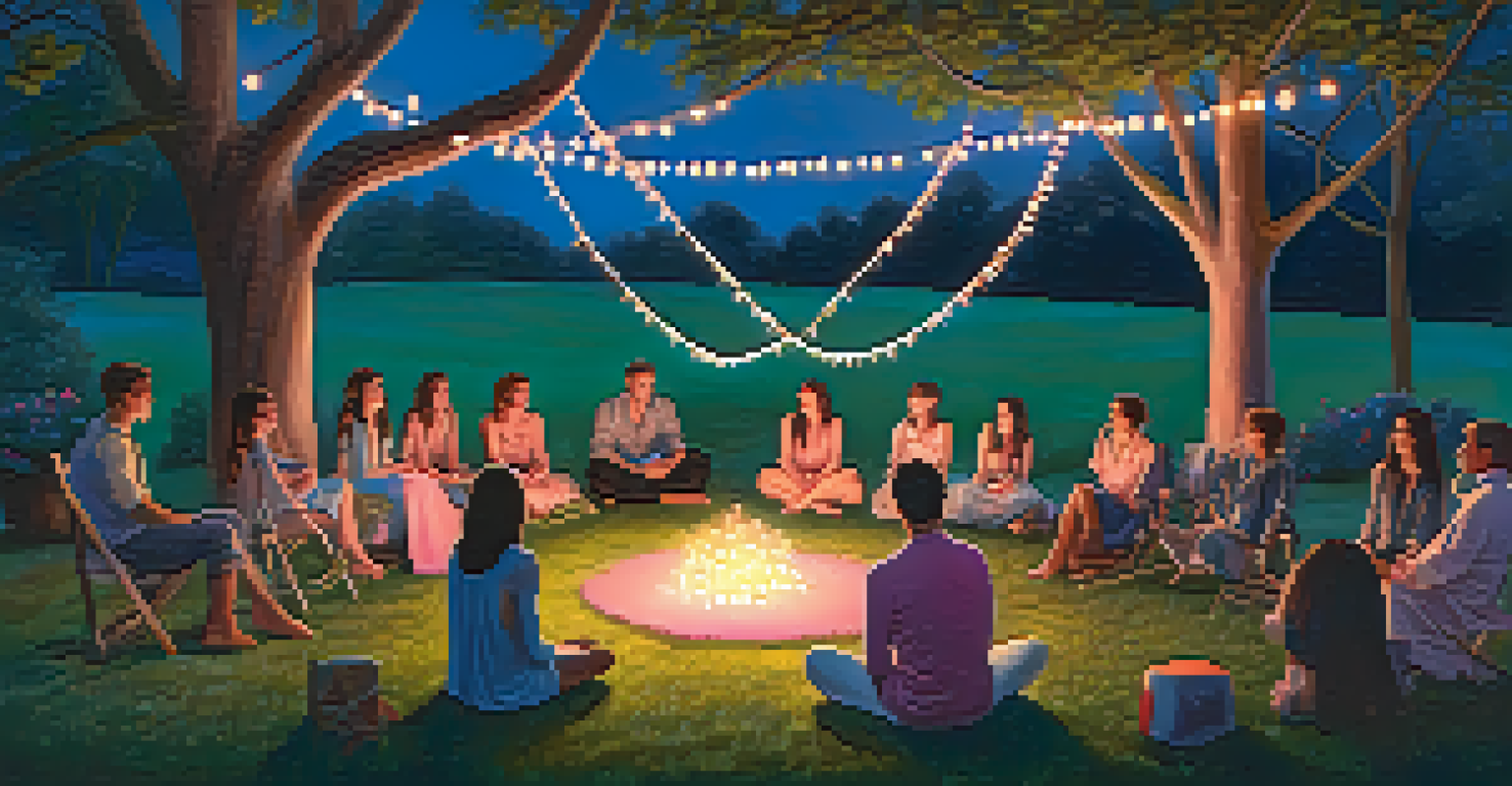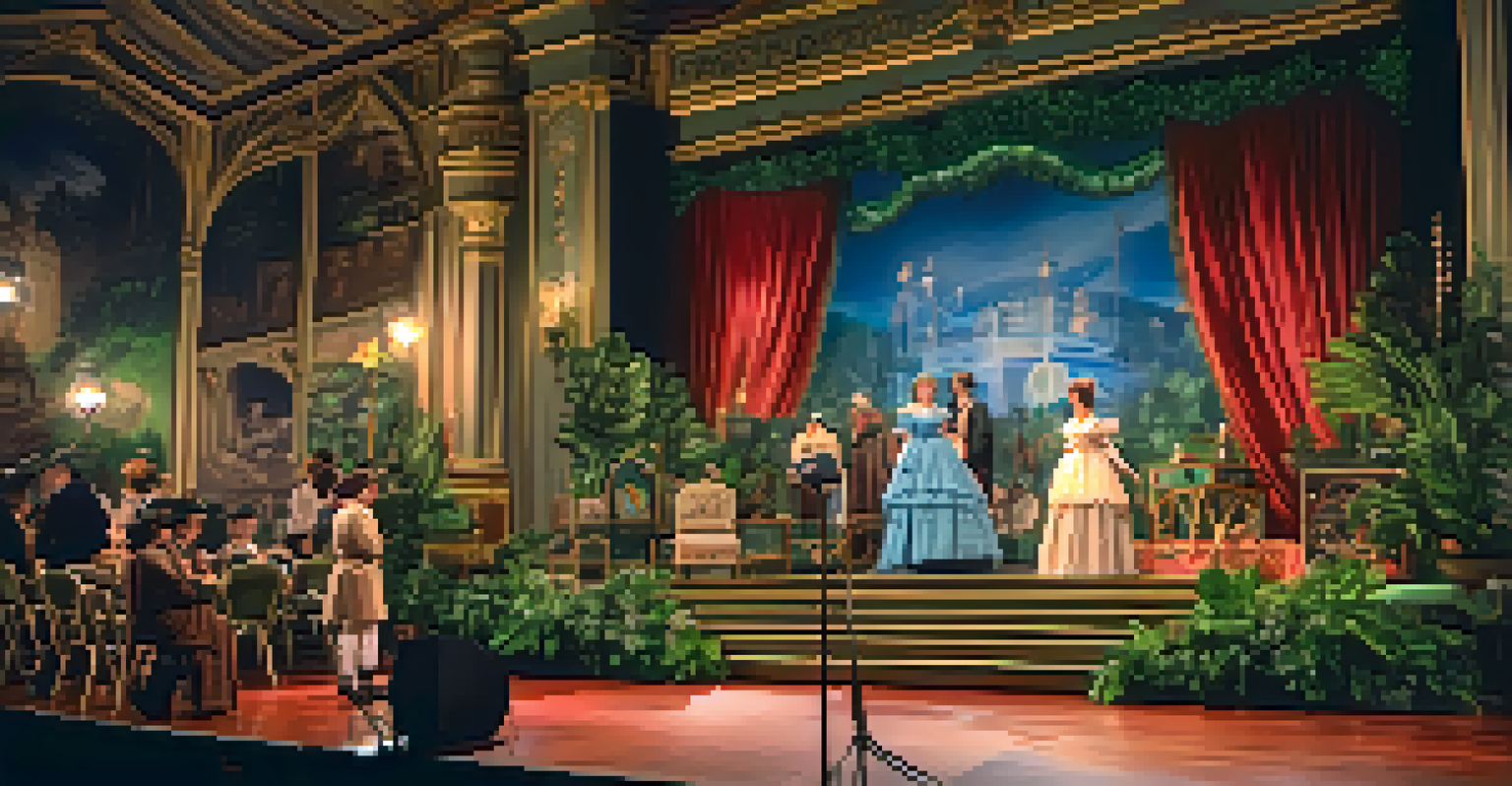How to Create a Magical Atmosphere for Your Performances

Understanding the Importance of Atmosphere in Performance
Creating a magical atmosphere is essential for captivating your audience. The right ambiance can enhance emotions and make the performance memorable. When viewers feel enveloped in the environment, they are more likely to connect with the story being told.
The stage is not merely a piece of scenery; it is a living organism that interacts with the performers and the audience alike.
Think of atmosphere as the stage's personality; it sets the tone even before a single word is spoken. Whether it's a dimly lit room or a vibrant festival, the atmosphere provides context that influences how the audience perceives the performance. A well-crafted environment engages all senses, drawing people deeper into the experience.
Moreover, an enchanting atmosphere can transform a simple performance into an unforgettable journey. By understanding how to create this magic, you'll not only elevate your craft but also leave a lasting impression on your audience.
Choosing the Right Venue for Your Performance
The venue plays a pivotal role in establishing the atmosphere. Selecting a location that aligns with the theme of your performance can amplify the emotional impact. For example, an outdoor setting can evoke a sense of freedom, while an intimate theater might create a cozy, personal connection.

Consider the venue's size, layout, and acoustics as well. A small, enclosed space can generate a feeling of closeness, while a grand hall might inspire awe. Each choice affects how your audience interacts with the performance and each other.
Create a Magical Atmosphere
An enchanting atmosphere draws the audience in, enhancing their emotional connection to the performance.
Ultimately, the right venue can be a silent collaborator in your performance, enhancing every moment and making the experience truly magical. Take the time to explore various options and envision how they can complement your artistic vision.
Using Lighting to Create Mood and Emotion
Lighting is one of the most powerful tools in creating a magical atmosphere. By manipulating light, you can evoke specific emotions and guide the audience's attention. Soft, warm lights can create a sense of intimacy, while stark, cold lighting may evoke tension or drama.
The magic of theater is that it transforms the ordinary into the extraordinary, creating a world where anything is possible.
Consider using colored lights or special effects to enhance the mood further. For instance, a soft blue light may suggest tranquility, while vibrant reds can create excitement or urgency. Experimenting with different lighting setups can also lead to unexpected and captivating results.
Remember, the goal is to complement your performance, not overshadow it. Thoughtful lighting choices can transform a scene and enhance the storytelling, making your performance resonate even more with the audience.
Incorporating Soundscapes and Music for Immersion
Sound is another crucial element in crafting a magical atmosphere. Background music or ambient sounds can transport the audience into the world of your performance. Imagine the difference between a performance accompanied by serene nature sounds versus one in complete silence.
Choose music that aligns with the emotions you want to convey. Whether it's an orchestral score or subtle acoustic melodies, the right sound can enhance tension, joy, or sorrow in a scene. Additionally, consider using sound effects that complement actions on stage, creating a multi-sensory experience.
Select the Right Venue
Choosing a venue that complements your performance can significantly amplify its emotional impact.
By thoughtfully integrating soundscapes, you can envelop your audience in the narrative, making them feel as though they are part of the story. This immersion is key to creating that magical atmosphere you desire.
Setting the Stage with Props and Decorations
Props and decorations are visual tools that can help tell your story and enhance the atmosphere. They create a tangible connection to the performance, allowing the audience to engage more fully. For example, a carefully chosen backdrop can transport viewers to another time or place.
Ensure that the props you use are not just decorative but also serve a purpose in the narrative. They should complement the themes and emotions of your performance, making everything feel cohesive. Thoughtfully placed decorations can draw attention to significant moments, adding to the overall experience.
Ultimately, your stage design should reflect the essence of your performance. When done right, it invites the audience into your world, adding layers of meaning and making the experience all the more magical.
Engaging the Audience with Interactive Elements
Involving the audience can significantly enhance the atmosphere of your performance. Interactive elements, such as audience participation or immersive experiences, can create a sense of connection and excitement. When viewers feel like part of the performance, it transforms their experience into something uniquely personal.
Consider ways to incorporate audience interaction, whether it's through direct engagement or creating spaces where they can contribute to the atmosphere. This could be as simple as inviting them to respond to certain moments or encouraging them to explore the space before the show begins.
Engage with Interactive Elements
Involving the audience through interactive elements transforms their experience into something personal and memorable.
By breaking the fourth wall, you invite your audience into your world, fostering a shared experience that lingers long after the performance ends. This level of engagement can help cultivate a magical atmosphere that resonates deeply with everyone present.
Mastering Your Performance Skills for Impact
While creating an enchanting atmosphere is crucial, the performance itself must shine. Mastering your craft ensures that the magic you create resonates with the audience. This includes honing your delivery, expressions, and interactions to effectively convey the emotions of your story.
Practice is key to building confidence and ensuring that your performance captures the essence of your vision. Rehearsing in the intended environment can help you adapt to the atmosphere and develop a natural flow that feels authentic. Think of it as finding your rhythm within the magical space you've created.

Ultimately, your performance skills will elevate the enchanting atmosphere you've set, making the experience not just memorable but truly transformative for your audience.
Evaluating the Experience and Seeking Feedback
After your performance, take the time to reflect on the atmosphere you created. Did it resonate with your audience? Gathering feedback can provide valuable insights into what aspects worked well and what could be improved. This process is essential for evolving your craft and enhancing future performances.
Encourage your audience to share their thoughts, whether through informal conversations or structured feedback forms. This engagement not only helps you grow but also fosters a sense of community among your viewers, making them feel valued.
Remember, creating a magical atmosphere is an ongoing journey. Each performance is an opportunity to experiment, learn, and refine your approach, ultimately leading to even more captivating experiences for your audience.